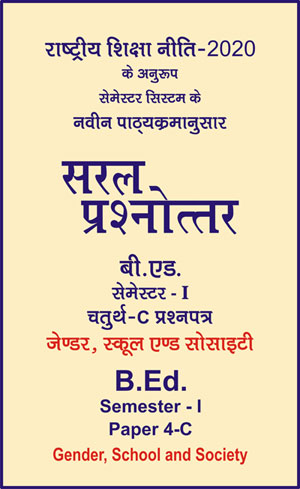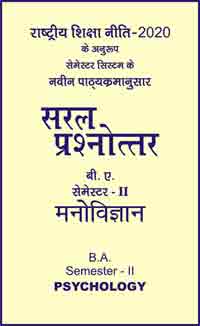|
बी एड - एम एड >> बी.एड. सेमेस्टर-1 प्रश्नपत्र-IV-C - जेण्डर, स्कूल एण्ड सोसाइटी बी.एड. सेमेस्टर-1 प्रश्नपत्र-IV-C - जेण्डर, स्कूल एण्ड सोसाइटीसरल प्रश्नोत्तर समूह
|
5 पाठक हैं |
||||||
बी.एड. सेमेस्टर-1 प्रश्नपत्र-IV-C - जेण्डर, स्कूल एण्ड सोसाइटी (अंग्रेजी भाषाा में)
Question- Write a note on violence against women.
Related Short Answer Questions
- How many cases of dowry harassment are reported in India?
- What are the personal beliefs due to which no woman raises her voice against violence?
Answer -
Violence against women is of both physical and psychological meAnswer - Aggression and violence are socially accepted characteristics of masculinity that exert power in patriarchy. The continuing practice of dowry in the society proves that violence against women is an ideological issue and hence it needs to be addressed in a very balanced manner. It is a very complex phenomenon under which many dimensions of violence are involved. In India, about 22 women are killed every day for dowry. In the last three years, about 24,771 deaths related to dowry have been registered across the country and Uttar Pradesh, Bihar and Madhya Pradesh have the highest incidence of dowry deaths. According to the data of the National Crime Records Bureau, about 3.48 lakh cases have been registered in the country where husbands or their relatives have committed brutal atrocities on women. West Bengal tops the list of such tragic cases where 61,259 such incidents have been registered in the last three years. It is followed by Rajasthan second with 44,311 incidents and Andhra Pradesh third with 34,835 incidents (The Pioneer, 2015). A 2015 crime bureau report highlights that there are 59,277 cases of abduction and coercion of girls and women (2.01 percent of the total criminal cases under the IPC); 82,422 cases of eve-teasing (2.79 per cent of the total criminal cases under IPC); 24,041 cases of sexual harassment (about 1.18 percent of total criminal cases committed under IPC) and 34,771 cases of rape (1.18 percent of total criminal cases under IPC) were made to protect women from domestic violence. Despite the 2005 Act (PWDVA), 1,13,403 cases of brutal atrocities committed by husbands and their relatives (3.85 per cent of the total criminal cases under IPC) were registered. This type of violence has a negative impact on the lives of girls, on their access to education and on their better performance in schools.
The crime rate at any place is one of the primary indicators that reflect the prevailing socio-economic situation in that place and the efficiency of the justice system there. Most of the women who are raped or sexually assaulted, in many cases do not report those crimes to the police because they have little confidence that the perpetrator will be punished. Many reasons are responsible for not registering crimes against women in the country.
Social stigma attached to crimes against women: Crimes against women are not given much importance in a male dominated society because women are not so self sufficient that they are able to take their own decisions and therefore depend on the mercy of their parents, mother-in-law or other male members of the family. The reasons for non-reporting of crimes committed in the family; This is the main reason among them. Shame and annoyance and the desire to treat attacks on themselves as personal matters are also reasons why women do not register atrocities against them.
Disdain or fear of the offender or other personal beliefs: Many crimes involving women go unreported because the perpetrators threaten to do more harm to them or their families. The result of these reasons, including the absence of a deterrent mechanism, is that all crimes against women go unreported.
Lack of trust in the criminal justice system: The slow pace of the justice system, as in India, is also one of the main reasons why women and even educated women fail to register crimes against them.
Violence against women perpetuates structures of gender oppression; Whether this violence has been done by individuals in the private sector or by institutional forces in the public sector. The social relations of caste and gender are also based on the exercise of power through the use of force. (Kannabiran and Kannabiran, 1991).
Power sets the purpose for patriarchy. But, mixing it with misbehaviour or masculinity becomes problematic.
|
|||||













